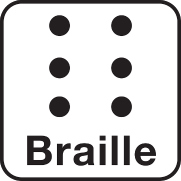|
Reading Without Seeing: Louis Braille and the Braille Alphabet
 Brief Description Brief Description
In this lesson, students explore the Braille alphabet and the contributions Louis Braille made to society.
Objectives
Students learn about Louis Braille and the Braille alphabet and explore some of the challenges people with impaired vision might face.
Keywords
Louis Braille, Braille alphabet, blindness, disabilities, senses
Materials Needed
computers with Internet access, Braille History, overhead projector or chalkboard, small paper bags, alphabet blocks, alphabet ink stamps, The Braille Alphabet, paper punch, construction paper, glue sticks, index cards, student journals
Lesson Plan
- Begin by sharing a bit of background information on Louis Braille at the Braille History site. Discuss with students what having impaired vision might be like. Record students' thoughts on an overhead projector or a chalkboard.
- Distribute a few alphabet blocks in a bag, and ask students to identify each letter by feeling it. Discuss the results. Was the method successful? Why or why not?
- Place several alphabet ink stamps that spell a word into small bags. Arrange students into groups, and give each group a bag. Have students reach into the bag, feel the stamps, record the letters they feel, and determine the word. When everyone has had a turn, take the stamps out so students can see whether their sense of touch provided the correct answers. Discuss the results. Was the method successful? Why or why not?
- Invite students to study The Braille Alphabet. Print a copy of the alphabet for each student. Have each student punch dots from construction paper and glue them to an index card to create a Braille version of his or her name. Place the cards in a box, and ask students to take turns pulling one out and "reading" the name.
- After students have completed the activities, ask them to record their experiences in their journals. Encourage them to include their thoughts about both their frustrations and their successes.
- Encourage students to share the activities with their parents or other family members.
Assessment
Evaluate students by observing the activities and discussions, reading their journal entries, and getting feedback from parents.
Lesson Plan Source
VaReane Heese, ([email protected]) Springfield Elementary School, Springfield, Nebraska
[ SUBMIT YOUR LESSON PLAN ]
01/14/2015
In an effort to keep our Lesson Plan Database as current as possible, please email the webmaster to report any links that are not working.
|




 Brief Description
Brief Description